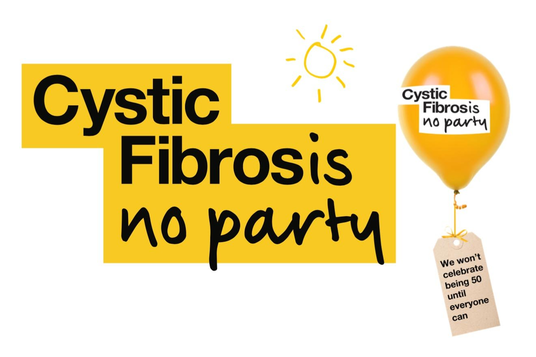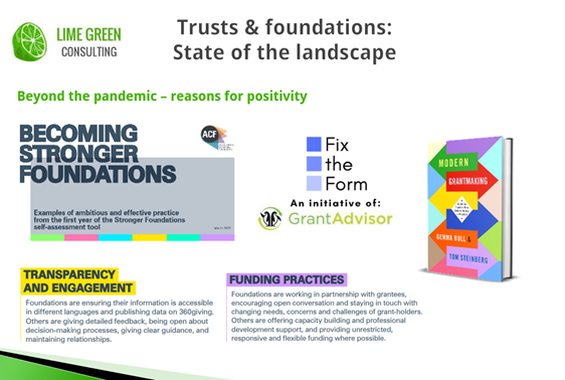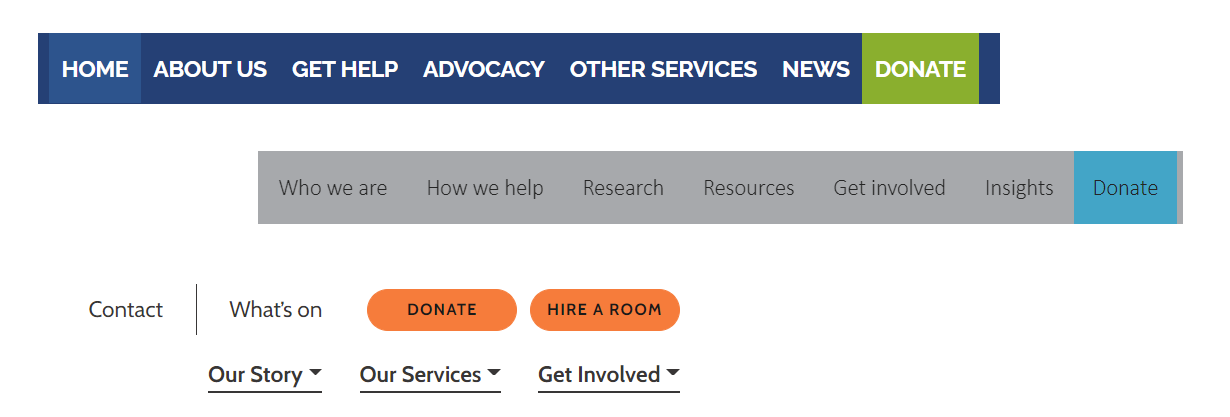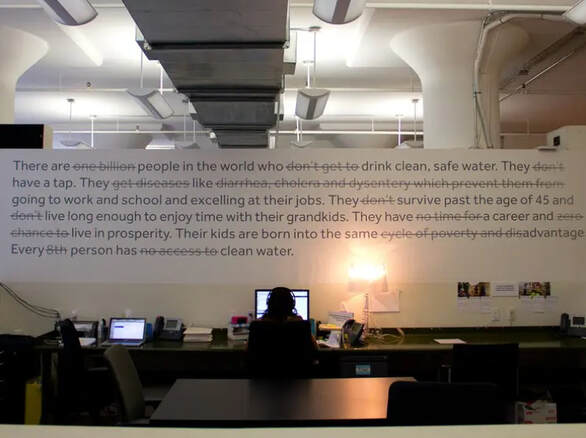|
It’s been nearly five years since we first shared some tips on creating an ethical fundraising policy, and 2-3 years since we really embraced the complex debate about problematic philanthropy. To kick off 2023 on a thoughtful note, this new blog brings together those ideas - and some new ones - for anyone looking to create an ethical fundraising policy. Problematic philanthropy - not as clear-cut as it seemsSummer 2020: the statue of Edward Colston makes its journey from high-profile city-centre plinth to horizontal resting place in a Bristol museum, via a swim in the River Avon. The charity sector is awash with talk about the issues with accepting grants and donations linked to historical figures involved in the slave trade. There’s a clear view – philanthropy can’t be used to excuse or whitewash the injustice of how wealth was first made. Spring 2019: the Sackler Trust halts grantgiving in the wake of the Purdue Pharma scandal. The US pharmaceutical company, closely linked to the Trust, is accused of fuelling the US opioid crisis that killed almost half a million people, having spent years aggressively pursuing legal action so they could continue selling their highly addictive drugs. Slowly, UK cultural institutions like the British Museum and the National Portrait Gallery begin distancing themselves from the Sackler name. Clear-cut cases like this make us all understand the need to swerve “bad money”, and make the process of writing an ethical fundraising policy seem pretty straightforward. Except that (mixed metaphor alert) once you open this can of worms, you get hit by about a million grey areas. Consider the following examples: Despite the Colston backlash, there are plenty of other links between the slave trade and the charity / arts sector hiding in plain sight. Here in Bristol, the Society of Merchant Venturers continue to donate £250,000 per year to local causes. In London, the Tate Galleries continue to take their name from Henry Tate, whose Tate & Lyle sugar company was fundamentally connected to the slave trade. Many UK charities happily receive small-scale income via the Amazon Smile programme, despite Amazon being associated with a raft of harmful practices including “extreme tax avoidance, poor working conditions in factories, slave labour in their supply chain, and catastrophic environmental impact” (source: FRIDA). And how many charities have received grants from household name corporate foundations like the Lloyds Bank Foundation, Santander Foundation and the RBS Skills & Opportunities Fund? Yet consider this quote from a 2018 report by Ethical Consumer magazine: “The UK's big five high street banks [Barclays, HSBC, Lloyds, RBS and Santander] are hindering the sector's efforts to tackle climate change by continuing to profit from some of the world's dirtiest fossil fuel projects. [...] The UK's mainstream banking industry has involvement with virtually every ethical ‘problem sector’ from factory farming through to nuclear weapons.” The case against philanthropy - and the dilemma for charities and social enterprisesNone of this is about passing moral judgement on the specific names above, merely to demonstrate how much more complicated things are than Edward Colston and the Sackler Trust. An uncomfortably high number of philanthropists and foundations have clear links with the slave trade, climate damage, tax avoidance and damaging employment practices - all of which actively harm the very people many charities exist to help. As we argued in 2020, philanthropy buys a seat at the table for a very specific audience - wealthy, privileged, usually white and male. Through their decisions on what they do/don't fund, their roles on Boards and advisory groups, and their status as thought leaders, they gain disproportionate influence in implementing their own vision of equality, social change and climate justice - a vision that is probably very different from your own. This gives rise to some important questions about what criteria should you apply when evaluating donations:
Given this moral and philosophical minefield, how do you go about creating an ethical fundraising policy?Firstly, here’s how not to do it… Don’t go out and find a template ethical fundraising policy, copy and paste in some organisational details, and tick it off your to do list. As is usually the case, an honest, thoughtful discussion is a prerequisite to any good policy or strategy. Don’t base your decisions on the sum total of people’s personal beliefs, what you’ve seen other organisations do in the past, or what the loudest voices are saying (whether that's your senior leadership, trustees or existing donors). And don’t over-react to any specific recent event in the media. If you do, you’ll be basing your decisions on the wrong criteria, oversimplifying complex issues, and setting yourself up for trouble. You may later find yourself facing pressure to turn away a donation that technically contravenes your policy in an unexpected way, or facing criticism for accepting a donation that has implications you hadn't considered. The first step is to organise a structured discussion or workshop, involving people at all levels of the organisation. Start by explaining the context, giving some examples of problematic donations to consider, and outlining the risks of getting your policy wrong. Feel free to share this blog with everyone in advance. The vital context for any good ethical fundraising policy is YOUR specific work and mission. You should look to identify types of donor or donation that might:
As a general rule, if this discussion is quick and easy, and everyone is readily in agreement, you probably haven’t given it enough thought! You should aim to arrive at a list of criteria for donations that you’d definitely reject, and donations that would prompt additional action, for example further research into the source of someone’s wealth, an in-depth discussion with your trustees, or a consultation process with your service users. Once you’ve made some headline ethical decisions, you still need to decide how to implement your policyFor example, you’re likely to need a due diligence process for gifts over a certain value, guidelines for approaching vulnerable donors, and an ethical checklist for any new third parties or suppliers. To decide what specific processes and guidelines you need, you should carefully map out all the types of fundraising your organisation does, and the potential ethical risks with each. You also need to support fundraising staff who are at the frontline of putting your policy into action. They need a safe space to be able to raise and discuss any ethical concerns, and a complaints process if they feel the organisation is breaking its own policy. And they need a fundraising culture that isn’t simply about results at all costs. A good ethical fundraising policy is quickly compromised by demanding or unrealistic fundraising targets that encourage people to forget any concerns and just pursue the cash. Training and workshop facilitationHonestly, this blog could have been twice as long. There are countless other examples and considerations I could have included, but I hope this is a helpful starting point. While creating an ethical fundraising policy can be complicated, but it’s a really empowering and important thing to get right.
To explore things further, we run periodic talks and Q&A sessions on ethical fundraising and problematic philanthropy - check out our training page for more information. And we've also facilitated ethical fundraising workshops for organisations, focused on both challenging debate and concrete decisions. Get in touch if you'd like to explore how we could run one with you.
1 Comment
This is a guest blog by Rosie Oldham. Rosie has more than ten years' experience as a fundraiser, and is currently Head of Fundraising and Communications at London homelessness charity Thames Reach. She previously worked for arts and homelessness charity Streetwise Opera and London Wildlife Trust, and recently joined the Board of the Badger Trust.
We love most attempts to challenge established ways of thinking, so we asked Rosie if she'd be willing to write this blog off the back of her tweet below about charity anniversaries. She kindly agreed - thank you Rosie!
Back in March, I was prompted to tweet about this after reading yet another string of threads in a sector fundraising group about plans to fundraise off the back of a charity’s anniversary. I was honestly frustrated at the precious and incredibly limited staff and volunteer time that was going into thinking about, planning and executing whole campaigns around this topic.
I’m also mentally scarred from seeing a senior member of staff spend an entire day designing a ‘birthday logo’ complete with balloons for a charity very early on in my fundraising career; this has probably clouded my view of charity birthdays forever. The conversation my tweet generated was fascinating! Many agreed and many disagreed, presenting different points of view about why their organisations think it is important to celebrate an anniversary year. What's wrong with celebrating your anniversary?
All that said, when might celebrating an anniversary be appropriate?
My flippant statement about charity anniversaries is definitely not a blanket one, and there were so many good points made in the discussion that followed. I’ve explored some of them below.
An example of an anniversary campaign that I love:
This is great because it’s actually a ‘non-campaign’ and ties this concept directly to the need for the charity’s work:
Cystic Fibrosis Trust ‘No Party’ - We won’t celebrate being 50 until everyone can In summary...has my opinion changed, and what should you do about your charity's anniversary?
Generally I still think that celebrating your charity’s anniversary is not a good use of time, and expecting people to give you money just because it’s your organisation’s birthday isn’t realistic.
This mostly applies to external audiences and especially to those who aren’t that close to your work. However I recognise I’m coming at this with a ‘fundraising hat’ on, and there are other reasons to celebrate a charity’s birthday than to increase support. So when you're next thinking about an anniversary campaign, or this conversation next comes up at your charity, what should you do?
Despite encouraging moves in the right direction, transparency and simplicity aren’t as common as you'd hope in the grantmaking world. We'd all love to think that funding is awarded based on the importance, quality and impact of the work taking place. Too often this gets confused with the quality of the application - which automatically puts some applicants at a disadvantage, including those whose first language isn’t English, or whose written English isn't as good, perhaps due to their education or background. Worse, it’s not even always as simple as writing a quality application. Because, with some funders:
All this is inherently unfair and counter-productive to the aim of achieving the greatest social impact. Fortunately, there are movements starting to address various aspects of this unfairness, including two we’ve written about before: Modern Grantmaking and Fix the Form. In the meantime, applicants who are well-connected or know how to play the system can still gain an advantage. Something I'm passionate about doing is trying to level the playing field for smaller and less experienced organisations. So this blog is about two things: good reasons for initiating contact with a funder before applying, and useful information to probe for once you’ve done so, to give you an advantage too. First, a few caveats:
With all this in mind, what are some good questions that you could reasonably phone a funder to ask?Proposal length and format: some funders request applications 'in writing' without providing much more detail. It's reasonable (as well as beneficial to them) to ask for their guidance on the recommended length, format, or a list of headings/information that should be included. Supporting documents: you might have important information that can't be included within the set questions or word limits on an online form - such as a case study, an infographic explaining impact data, or a key policy. You can ask whether these additional documents would be accepted, and how to share them - for example can they be emailed separately to a funder, if you can’t upload them to the form? Technical eligibility questions: even when funders try to establish clear guidelines around things like reserves levels, match funding or legal structure, there are often organisations and situations that fall into a grey area. It might only be possible to confirm your eligibility through an initial call, and funders are often willing to help with this. Once you’ve engaged a funder with one of these initial questions, what else might you be able to probe for?I'll often ask if I can give a 30-second summary of the organisation or project, to explore if it's the type of thing they'd be interested in funding. These discussions often yield surprisingly helpful information, for example:
Clarifying key phrases: funders may use terms like 'national significance' or 'systems change' without a clear explanation of exactly how they define or measure them. An initial conversation can help you understand their interpretation, and how you can best evidence that you're a good fit. Confirming focus areas: frustratingly, in practice funders sometimes have a more limited focus than they may indicate in their guidelines or charitable objectives. For example, I’ve heard: “Yes, in theory we do fund projects anywhere in the UK, but at the moment we're highly unlikely to support a project outside of Bristol, Bath and the surrounding area." Checking whether a funder is actually focusing on a narrower geographical or thematic area can save you wasting time on a fruitless application. Considering how much to apply for: again, funders may provide broad guidance on their website, but share more helpful information on the phone, especially once they've heard a bit about your work. Perhaps they'd consider awarding a larger amount because it's a project very close to their heart, or a smaller amount because it's an initial pilot, or maybe there's a threshold where if you stay below it, the assessment process will be simpler or quicker. Checking when to submit: I've had funders suggest that I hold back an application for a few months, either because they've been inundated with proposals in a particular funding round, or they've recently funded several similar projects and the trustees are unlikely to fund another one imminently. Equally, funders might give a reason why getting an application in very quickly is beneficial. This is almost never information that can be found on their website, but is incredibly helpful. I think it's far from ideal that you need to press for this type of information – it's not a fair way of doing things, or a great use of anybody's time. In an ideal world, every funder would have a clear website which they keep updated as their priorities shift, or when they get enquiries from applicants that show something isn't adequately explained. And, as I say, many funders are getting better at this. But in the meantime, probing for extra information is a key part of the job - because if you’re not getting and taking advantage of it, other applicants will be.
The cost-of-living and energy crisis is the latest major headache for charities and social enterprises, with many experts now predicting that the impact could be more severe than the pandemic.
When the outlook is so serious, and you have a million other things to do, it might be tempting to put off thinking strategically about this, and simply hope that the worst projections don't come true. But - I can’t stress this enough - this is a crisis to tackle head on, because there are things you can do to navigate your organisation through the worst of it. Firstly, how will charities and social enterprises be impacted?
As costs increase, the real value of existing grants and donations goes down. Again, let’s look at what Pro Bono Economics say: a grant worth £100,000 per year in 2021 will only be worth £94,000 by 2023, and a monthly direct debit of £20 in 2021 will have effectively depreciated to £17.20 by 2026. These figures are all based on inflation estimates that may already be too optimistic.
All this points towards you having to spend more to achieve the same impact - bad news, especially if you’re reliant on funders with antiquated views on how much things cost, and what they're willing to fund. But charities can’t control inflation and rising energy costs - so what can you do in response?1. Urgently re-budget
Before deciding what action to take, you need to understand exactly how your organisation will be impacted. This will depend entirely on your circumstances and what you do.
I believe that every Board and senior management team should be meeting as a matter of urgency and going through their budget with a fine tooth comb. Involving your fundraisers in this exercise will help them to understand key issues and make a stronger case for support later. For example:
Budgeting for these cost increases - both those that you have no control over, and those that you want to implement if funding allows - can be a stressful exercise. But it’s vital to look for these dangers ahead of time, as it'll put you in a better position to respond appropriately (see below). 2. Ask funders (and donors) for help
As with other recent crises, how well the voluntary sector can survive the storm depends on whether funders step up to the plate. I'm really hoping they will, especially if enough people ask the right questions.
If you’re currently in receipt of a multi-year grant, contact the funder and explore whether it's possible to renegotiate the grant amount for future years, based on the unexpected and unavoidable rise in your costs. If you’re considering applying for a new grant but the funder’s criteria are very restrictive - for example if they’ve had the same blanket rule for years about how much you can include for overheads - explain how your budgeting shows that this is no longer viable for your organisation, and ask whether they can offer any flexibility given the current crisis. By doing a proper re-budgeting exercise in advance, as described above, you can make a more convincing argument to funders, and portray your organisation as financially responsible. Many funders did show an admirable level of flexibility and understanding during the pandemic, and they genuinely want to help, so don't be afraid to ask these questions. To give an example that we've shared previously:
And like I always say, if a funder’s restrictions or policies put your organisation at financial risk - for example, if they won’t include a contribution towards running costs or allow you to budget for inflation - don’t be afraid to walk away if necessary.
Asking for help applies to other fundraising audiences too. If I were a Fundraising Manager at any organisation right now, I'd be developing some honest and carefully-worded messaging about the impact of rising costs on our work, to share at the appropriate time with regular givers, major donors and corporate partners. Of course not everyone will be in a position to increase their donation, but few will resent being asked. If any of the charities that I currently donate to contacted me to request a 10% increase in my monthly direct debit, to ensure they could sustain their impact amid rising costs, I’d be doing whatever I could to help. 3. Look for cost savings
This crisis isn’t your fault, but there will still be things you can do to make savings, even if this only makes a modest difference in the face of rising costs.
For example, here's some excellent advice from small charity finance expert Liz Pepler on how some charities can make savings by claiming reduced VAT on fuel and power, as well as maximising Gift Aid:
Spend some time identifying your own biggest potential saving areas and researching cost-cutting techniques - there are many excellent tips out there. For example, I’ve heard of organisations compiling energy-saving tips for staff, changing cooking techniques and recipes, and reviewing routes and providing fuel-saving tips if they do a lot of driving. Just watch out for scams or anybody trying to sell you something that sounds too good to be true.
Finally, some helpful links for further advice
There's plenty to worry about at the moment - in fundraising and in society. With every passing crisis, charities and social enterprises face increasing need, but more financial pressure - and it’s no different now with rising inflation and the cost of living crisis.
On top of that, there’s much entrenched frustration directed at funders, whose grantmaking processes and policies add a further headache. Only last week, new research estimated that organisations spend £900million per year meeting the demands of applying to funders. Our own blog charts this rising frustration. We've written almost enough rants to fill a small book, whether about the human cost of bad application processes, the need for funders to turn over a new leaf, the injustice of the lack of infrastructure core funding, or the general frustrating things that funders say. While it feels important to be honest and realistic about these challenges, it's also nice to focus on positivity where we can find it. And it's true that the pandemic has prompted some positive reflection and reform from many progressive funders. When updating our training content recently, I really enjoyed preparing this slide highlighting some of the current movements and reports on grantmaking that give us reasons to be optimistic. I don’t think it’s a coincidence that it’s also one of our most colourful slides:
On the right of this slide is a book that I’ve been promising to review for months, because it gives a glimpse of a possible future for grantmaking that is better for everyone - more accessible, more respectful, more even-handed, and more impactful as a result.
Modern Grantmaking is written by Gemma Bull and Tom Steinberg. Both have worked for funders and been responsible for giving away money - a job that many people, particularly those outside the sector, might think sounds enjoyable and straightforward, but is actually fraught with challenges. Both have evidently experienced the creeping unease and frustration that comes with the territory of seeing money given away badly. So they sat down and spoke to countless experts about what the common issues are, and what good grantmaking should look like – and Modern Grantmaking is the result. Obviously, this book isn't written for people like me who seek funding, but for those on the other side of the fence who give money away and want to do it better. But for fundraisers, there's plenty of useful insight - and reassurance - in understanding more about the issues that grantmakers are wrestling with. The first reason for positivity is simply that a modern grantmaking movement exists. That a growing number of people in influential positions are talking and writing about how grantmaking isn’t good enough, and how it can be better. Early on, the authors write that in the last decade, such ideas are “growing up like green shoots through cracks in a pavement. These shoots are now so numerous and so vigorous that the paving slabs of traditional grantmaking practice are threatening to buckle.” Yet I wonder how many of these reformist ideas actually make it far beyond a tight circle of people. Certainly, the vast majority of fundraisers who come on our training courses and share frustrations about the things funders say and do, show little sense of this buckling pavement under their feet. So to have a new book that brings together these ideas, shouts about the need for reform, and signposts people towards a number of growing modern grantmaking movements, is a beacon of hope for fundraisers in a difficult landscape. As well as influencing funders, this helps to legitimise the frustrations that fundraisers feel, and galvanise them to find small ways to challenge and push back. If more of us are talking the same language, change happens faster. Last week, I saw a small but significant example of this on Twitter:
Modern Grantmaking gave me a telling glimpse into the curious career of a grantmaker - one with few structured development opportunities, and little incentive to do things differently. In the authors’ words, "grantmaking can also be an ideal career for people who just want a quiet life and a reliable salary.” Firstly, grantmaking comes across as at best a very young profession, and arguably not a recognised profession at all. The authors explain how there's no established career path into grantmaking, very little tailored training to help with the key skills required, and no accreditations or recognised standards to measure performance against. Secondly, there’s not much accountability. In a world without enough funding to go around, if a funder treats you badly, where are you supposed to take your ‘business’ instead? Can you afford to complain? If funders don’t recognise themselves as needing to provide a service to grantseekers, they won’t measure themselves in those terms. Reading this, suddenly many of my past experiences with funders made sense. Seeking funding is a lot like being a UK rail passenger - you might not enjoy the experience, it might feel unpleasant and at times dehumanising, but good luck finding an alternative. Now imagine the added fear that if you complain about the delays and overcrowding, they might simply stop offering you a seat at all.
It's cathartic to read this insight in Modern Grantmaking, and I'd recommend you do so yourself. But the best thing about the book is how it creates an alternative vision for grantmaking, as a profession with the service mentality, the standards and development opportunities, and the pressure to be better.
There's advice about how to recognise and manage the power and privilege that you have as a grantmaker. How to convince colleagues that you may not have the right perspective and lived experience in the room to evaluate funding proposals and make fair decisions. How easy it can be to strong-arm a charity into completely changing their project or budget, because of a seemingly innocuous suggestion you make. There are whole chapters dedicated to improving how you treat applicants, even if nobody is demanding it. How to understand what the experience is like for grantseekers trying to navigate your website, fill in your application form and go through the agonising wait for a decision - then take steps to improve that experience. A recurring theme is the importance for humility - just because you have all the money, it doesn’t mean you have all the knowledge. For grantmakers with this mindset, the book contains practical advice on how to commission independent research to understand a social issue well enough to judge funding proposals, and how to start reading evaluation reports with a critical eye that genuinely broadens your understanding, rather than just looking for quick evidence that your grants are working.
Reading all this was music to my ears as a fundraiser. And what makes Modern Grantmaking so convincing is that it’s peppered with horror stories of grantmaking done badly, and inspiring case studies showing how funders have reaped the benefits of making positive changes.
The book also has a real grassroots feel. While it may be picked up by the occasional Chief Executive of a funder, it's really written for those people whose day-to-day work has the power to make grantseeking a good or a miserable experience – the people who design application forms, respond to emails and answer the phones. Of course, we can hope that these people will still influence those working above them, and will ultimately go on to lead trusts and foundations in the future, and set a new standard for grantmaking. I hope that any grantmaker wanting to genuinely maximise their social impact will read Modern Grantmaking, then do what they can to push through change. I guess that will be the ultimate measure of the book’s success. But, in the meantime, if you’re a frustrated bid writer wondering if, how and when things will ever be done better, I’d also recommend getting yourself a copy - you’ll be able to take plenty of ideas and much-needed hope from it. You can buy your copy of Modern Grantmaking, and read more about the movement and the authors, by clicking here. So you're getting started with public fundraising...but do people even know you're a charity?16/6/2022
We do a lot of strategy work with organisations that need to make a major change in how they raise money, and become a true “fundraising charity” for the very first time.
They're often very established organisations with a significant turnover, who have been delivering successful services for a long time. But they're coming at public fundraising from a standing start, often prompted by an unexpected development like the loss of a key statutory contract, or the realisation that grant funding alone is no longer enough to sustain them. For organisations like these, helping them with everyday fundraising tactics is only part of the focus. Yes, they may need to decide when to run appeals, whether to set up a regular giving scheme, what suggested donation amounts to use. But they also face a more fundamental challenge - they need to make people aware of the simple fact that they're a charity in need of public support. We live in a world where everybody loves to have an opinion on charities - what they do, how they fundraise, how much they’re allowed to pay for things - but most people have little sense of what a charity is. They certainly don’t realise that it includes a vast range of organisations that they use every day - including schools, hospitals, community centres - or the extent to which these organisations are increasingly reliant on public support to stay afloat. Tinkering with fundraising tactics won’t achieve very much unless you can address this fundamental issue. So this blog is all about some ways to communicate the fact that you’re a fundraising charity at all. 1. Be open about why you need support
There's no shame in not being able to accomplish everything you want with just statutory or grant funding, particularly in the current climate. But if people don’t see you as a fundraising charity, and haven’t heard you ask before, they're going to need educating about what you need, and why now.
Be honest and matter-of-fact about your funding realities, and be prepared to debunk myths. People might be surprised to know that you don’t receive local authority funding, or a lot less than you used to. And focus on the positive side of your fundraising - identify things that you’d love to be able to do or provide for your service users, that you know they want and need, and explain how donations will enable these things to happen. Discussing this internally will enable you to craft a concise, convincing fundraising message that gives motivation and confidence to your organisation, staff and volunteers. You can then deploy this message in all kinds of ways, as we've outlined below. 2. Put the basics in place
Successful fundraising charities all have one very obvious thing in common - they openly ask for money. But it’s amazing how many organisations starting out with public fundraising don't do this clearly.
Make sure you have a prominent donate button on your website homepage and navigation bar. Include basic fundraising messages regularly on social media and in your newsletter. These shouldn’t be too pushy or intrusive, but they need to be there. And they don’t even need to be particularly-well crafted at this stage to have an impact. Taking these steps won’t raise much money on their own, but they will ensure that people who interact with your organisation become aware that you’re trying to raise money from the public, which is the first way to shift perceptions. 3. Place fundraising messages everywhere that people interact with you
But people don’t just engage with your organisation via your website, newsletter and social media. If you're a community-based organisation, there will be plenty of other opportunities - perhaps you run a local café, a community centre, or deliver services or events in your community.
This is where the magic happens. People will see your organisation in its best light - helping people, providing work or volunteering opportunities, building grassroots relationships. Visitors will be feeling warmth and goodwill towards you - so not having a fundraising poster on the wall, or a ‘donate now’ message on a till, is a missed opportunity. Again, don’t expect these things to raise loads of money initially, and be mindful that many people won’t be a in a position to donate. But you're still changing how your organisation is seen, and introducing timely messaging that some people will act on. 4. Celebrate every success
When you're first starting out, fundraising success stories may be limited, and the financial numbers small - but you still have something to shout about.
If somebody makes a modest donation, thank them publicly (ask their permission first, or do it without mentioning their name or details). If somebody does a fundraiser for you, write a short news article or social media post about it. If you have a loyal supporter, consider interviewing them and sharing their story about what they do and why they donate. This achieves three things. Firstly, it's another way of communicating that you're an active fundraising charity, offering more variety than just a financial ask. Secondly, it shows that you value donations and fundraising support, and that even modest contributions are important to you. Finally, it's 'social proof' - seeing that people are supporting you will inspire and encourage others to do the same. 5. Talk about fundraising with your whole team
When you make the shift to being a fundraising charity, you need to bring everyone along with you. There's a common saying that “everybody is a fundraiser” - that’s not quite true, but certainly every staff member or volunteer can be an ambassador for you.
Crafting your central fundraising message (see above) is also an internal exercise – it's important that everyone understands why you're stepping up your fundraising, and what you can achieve if successful. Some staff will need help to overcome any misconceptions they have about fundraising, and identify small ways in which they can personally help. Keep fundraising on the agenda by literally making it a regular agenda item in staff meetings, even for project staff. Every day, they'll be interacting with service users who might consider doing small-scale fundraising activities, or family members who might be in a position to donate. So this provides an ongoing mechanism to identify new fundraising opportunities and ideas, as well as addressing any barriers or teething problems. According to Wiktionary, the above proverb is used to describe "a disappointing or mundane event occurring straight after an exciting, magnificent, or triumphal event." Now it's a stretch to call any strategy process magnificent or triumphal - I love strategic planning and even I wouldn’t go that far. But you can probably remember a time when you saw a new strategy launched with much fanfare, the product of many exciting conversations about the future, and then…nothing. The strategy goes to its final resting place in a dusty drawer or the dark recesses of your shared drive, and everybody goes back to their daily business as if nothing has changed. This is a huge waste of time. Everybody knows it, but it still happens more often than most people care to admit. At Lime Green, we try to make any strategy process as collaborative and inclusive as possible - I'm a firm believer that the conversations are as important as the final document. You need to involve people from all levels of your organisation, rather than entrusting a senior leader or consultant to sit in their ivory tower and write your strategy alone. But this alone isn't enough to avoid the pull of the strategy graveyard. There are loads of resources out there about how to create a strategy, but very little on the all-important topic of what to do after you've finished it. So here are some tips for making sure your published business plan or fundraising strategy remains a useful and relevant guiding document… Organise launch sessions for all staffExpecting everyone to independently read and engage with a new strategy is a tough ask. Even if they want to, the realities of their job may get in the way, and words on a page are rarely that exciting or inspiring. This is where a strategy launch session - for the whole organisation or your particular team - can work really well. Ask people to read the strategy in advance, but be prepared to summarise key points at the start. Encourage staff to ask questions, voice concerns, and think creatively about what they need to start doing differently to turn the strategy into reality. While this absolutely isn’t a substitute for involving people in the planning process, it's a great additional step. Providing a space to discuss concerns is important, because a new strategy can inadvertently make people worry about things like job security or underinvestment in their area of work. Dealing with these worries head-on will reassure people and make them engage more positively with what you want to achieve. Update your budget, plan and other resources to reflect your strategyIf a strategy is meaningful and well thought out, it should ultimately result in you changing the way you work - but it's not the strategy itself that does the heavy lifting. It’s highly likely you’ll need to update your budget and re-write your operational plan. Job descriptions and even job titles may need to be changed. Regular meeting agendas will need updating, so you can monitor and discuss the things that you’ve decided are most important. Forget to do this and your strategy quickly becomes irrelevant, because people won’t have the resources or permission to start doing things differently. Shout about your strategy to service users, partners and fundersA good strategy, with a bold vision and clear direction, should build confidence and trust in your organisation and improve how you work with others. If that’s the case, you want it out in the open. So make sure that everyone you work with knows about your strategy, understands how it changes things, and holds you to account for turning it into reality. But you can’t expect your strategy to be important enough to external people that they’ll sit down and read it in full. There may also be parts of it that are for internal eyes only. This is where a well-written executive summary or eye-catching infographic, which summarises key information in a concise and engaging way, can be hugely helpful. Make your strategy visibleI don’t just mean saving it somewhere easy to find, although that helps. If you've created a clear list of strategic priorities, milestones or values, make these impossible to miss. Print them and stick them up in your office and meeting room. Add them to login screens, backgrounds and screensavers. This makes your key messages impossible to forget and ignore, but it also shows pride in your strategy and promotes accountability - because someone, somewhere is going to look a bit silly if the whole team gets a daily reminder of all the things that the organisation changed its mind about doing. Show how your strategy is helping to achieve successIf colleagues are wrestling with a tricky decision, remind them to refer back to the strategy and consider how it could guide them. If following your new strategy has enabled some kind of success - securing a new grant, forming a new partnership or receiving positive feedback - shout about it from the rooftops. In my experience, there are enough badly-planned and painful strategy processes out there that a lot of people approach this type of work with a big dollop of suspicion and scepticism. Showing the value of a good strategy, and vindicating the time spent on it, can help to change attitudes. You'll be grateful the next time you need their time and input. Commit to a strategy reviewNo strategy gets everything right or accurately predicts the future. But that’s never a reason to hope everybody quietly forgets it ever existed.
To get real value out of a strategy, you'll need to review it part way through the strategic period, say after 12 or 18 months. Committing to this in the strategy itself, and scheduling a review process well in advance, makes it far more likely it'll actually happen. Just before you publish a strategy is a great time to identify anything that will particularly merit a review. If you've faced a particularly tough decision, or committed to a direction that some staff are worried about, then promise to revisit this. Thinking like this may give you a list of natural questions to work through later. This again builds confidence and accountability, and might persuade doubters to give something a try for a bit. March 2022 marked the end of an era, as the Small Charities Coalition (SCC) closed its doors for good. Hundreds of people listened to the voices and experiences of small charities by joining their final celebration event ‘The Power of Small’ or reading their ‘Small and Mighty’ follow-up report.
If you haven’t seen the report yet, it’s well worth a read. There are lots of interesting reflections on the value and future of small charity infrastructure support, as well as an announcement to bring relief to many: SCC’s free HelpDesk and Charity Set Up Tool will continue under the new joint stewardship of the NCVO and FSI. The question of how the sector secures long-term funding for this type of vital infrastructure support, and how we can get people to value it, still looms large. I was really hoping the report would tackle this head-on, but it doesn’t really say anything new - that’s a disappointment, but a topic for another day. The report outlines four Small Principles for those working with, funding and supporting small organisations. The first of these is ‘If you support or fund small charities, say so upfront.’ The context is that the small charities surveyed for the final report overwhelmingly said they trusted SCC because it was explicitly set up to support small charities, as well as being a small charity itself. While many organisations offer support and services to small charities as part of a much broader programme, this rarely inspires the same confidence. This is a really important point, and on reflection something we at Lime Green need to say more clearly on our website and elsewhere. While we don’t work solely with small charities, they were the original reason why we started, and remain the main audience for our consultancy, training and resources. So in response to Small Principle #1, this blog is about one thing: showing that we're here for small charities. We could never, and don’t want to, replicate the broad suite of support and services offered by an organisation like SCC. There’s loads we don’t do, in which case we'll always signpost to others. But if you need something that we do provide, I hope you’ll feel able to come to us with confidence. Here’s why: We're a founding member of the Small Charity Friendly Collective. Head this way to find out more about this amazing bunch of small charity specialists, each with their own specialist expertise - we're all committed to providing accessible support and free resources to the small charity sector. Our experience is small charity to the core. My entire time as a charity employee and trustee was with charities with a turnover below £1million. As a guide, in the past three years nearly three-quarters of our consultancy clients have been either registered charities or social enterprises below this turnover threshold, often significantly below it. This small charity experience shapes how we work. I’ve personally felt that frustration when support is unintentionally alienating or irrelevant for small charities. You know, assumptions that you have a marketing budget, a ‘team’ of fundraisers, available reserves. Training that leaves you with plenty of ideas but no clue where or how to start implementing them. This frustration drives our approach - we always strive to be relevant and proportionate for small charities. It's great to get positive feedback about the quality of our work, but I’m equally proud that we’re seen as being friendly, flexible and kind - easy values and cliches to put on paper, but only meaningful when backed up by feedback. We use expertise as a force for good. The knowledge and skills gained from working with a wide range of organisations can be a double-edged sword. Specialist expertise can solve problems, empower organisations and build confidence - but used incorrectly, it can overcomplicate things, demoralise people, and only serve to make the consultant look clever. We aim to do all of the former and none of the latter - in my experience, that's not as common in our sector as you'd think. While we do sometimes use specialist tools and frameworks (some designed ourselves, some borrowed from the business world), we’ll only do so if they genuinely solve a problem, and if we can explain to an organisation how to keep using them in-house. We strive to create practical content that make sense, and we’re vehemently anti-jargon - if you see us breaking these rules, please call us out! We create free resources specifically for small charities. Too often, I feel like fundraisers and consultants operate in an echo chamber, endlessly recycling and debating issues that may be interesting but are ultimately irrelevant for small charities, who form the majority of the sector. While we do of course write and talk about topical issues, we do so with the explicit aim of demystifying them and being practically-minded:
We train hundreds of grassroots organisations each year. We work with partners that focus on serving small organisations, including the School for Social Entrepreneurs and various CVSs (Councils for Voluntary Services). We were also an approved trainer for SCC up until their closure. Again, you’ll see that our training feedback reflects our small charity focus - I love that we’re seen as being warm, friendly and approachable, as making groups feel comfortable, structuring content clearly, and giving encouragement to people who are already doing things well. Working with us costs less if you're a small charity. We offer a guaranteed discount of between 10% and 28% (depending on the service) on our consultancy fees for small registered charities. The work we do with larger organisations helps to subsidise this, as well as generating new learning and resources that we can then use and share more widely. Thanks to the Small and Mighty report for outlining their four Small Principles for future small charity support. I hope we can rise to the challenge and do our bit. This month we're taking a breather from writing punchy opinion pieces or gazing into our crystal ball and focusing on something more straightforward but still vital - everything you need to know about the humble case for support. What do we mean by a case for support?A case for support is an internal document that you create to outline the problem your organisation exists to solve, what you do about that problem, and what you're going to achieve as a result. Quite literally, it's your case for why donors or funders should support your work. A good case for support effectively acts as a comprehensive, well-organised filing cabinet of convincing content that you can pull out whenever you need it - for a funding proposal, a meeting with a donor, to create copy for a webpage. It’s very unlikely that anyone outside your organisation will see - or would ever want to see - this full document in all its glory. But it should be the starting point for your external, donor-facing documents. It's never a case of just copy/pasting large chunks of content from your case for support into an external document and just adding images and a catchy title - the text will always need tailoring for the audience and context - but it’s still a brilliant shortcut. (Just to confuse things, often organisations create a shorter, branded external document to 'sell' their work to donors and also call this a ‘case for support’, but that’s not what we’re talking about in this blog.) Working with organisations to create their case for support is one of my favourite jobs. As well as it being a privilege to learn all about fascinating and important new causes, I love the process of asking a few targeted questions, rapidly building up an array of content on colourful post-its, then shaping it into a structured document. And organisations always seem to really value having that outsider’s perspective - while they can supply all the passion, lived experience and raw content, a few ‘devil’s advocate’ questions from us can help to clarify details, tease out vital extra information and explain things clearly and convincingly for an external audience. What are the benefits of developing a case for support?Many organisations shy away from creating a case for support, because they don't feel they have time. I’m not going to lie, it does take time to create. But it will certainly save you time in the long run, and also increase your return on investment from fundraising. A good case for support will equip you with:
What should you cover in your case for support?There are many ways to structure a case for support, and they can get pretty long and complicated, but fundamentally you need to cover four key areas: The need for your work:
Your ‘solution’:
Your impact:
Your expertise and credibility:
Where can you go for the information needed to create a strong case for support?There are loads of potential information sources to draw on, but here are a few:
This can feel like a daunting process if you’ve never done it before, but it's important to stress that you don’t need everything to get started. As it's an internal document, developing a case for support can be an ongoing, iterative process - start ASAP, but make a note of what else you'll need to research, gather and add over time. The best cases for support are never finished, they evolve over time. For example if new research is published that reinforces the need for your work, or if you've just written a brilliant answer (even if you say so yourself) to a specific funder question that you want to re-use in future, find a place for it in your case for support. If you're now convinced that you need a case for support, what should you do next?We’ve tried to write this blog as a stand-alone free resource for anyone wanting to get started on their case for support. Remember that you're the expert on your work and the reasons why you do it, and your case for support is just a way of laying all that out in a logical, structure way.
If you feel you do need some extra support, we’ve got a couple of options:
When the news that the Small Charities Coalition (SCC) is closing first broke, people expressed a range of emotions: shock, sadness, gratitude for their help, concern for the grassroots charities they support.
This is all justified, but I think there’s been too much resignation (that this is just one of those things that happens) and not nearly enough anger. I want to explain why this is a disaster - specifically for SCC and the many brilliant charities they support, but more broadly because of what it says about our sector and the lack of support for infrastructure organisations. This is a collective failure by grantmakers, resulting from short-sighted policy and too much ego.
First, a small disclaimer
I’ve been a pro bono trainer for SCC and general supporter of their work since 2015, so I can’t claim to be 100% neutral, although I should emphasise that we've never received any payment from our work with them.
Secondly, I don't have any knowledge of the inner workings of SCC, or exactly what they've done to try to secure funding. I'm sure there will have been things they could have done better or differently - that's the case for all of us - but I don't think that would fundamentally change what I want to say. Why is infrastructure support so vital for charities?
The vast majority of charities and social enterprises are tiny organisations run by people with lived experience of the issues they’re addressing. I've personally worked with so many brilliant founders who have been full of knowledge and passion, but who haven’t benefitted from professional training or the best education, don’t speak English as a first language, or have little money for professional development.
Inevitably there are times when they need expert support in areas outside their comfort zone - for example finance, fundraising or IT - but they don't have the budget to recruit a specialist staff member, or pay a consultant. Sometimes they secure ad hoc pro bono support from an expert – frequently a wealthy person in the twilight of their career after spending 40 years making money in the finance and business worlds, often perpetuating the same social issues they now claim to want to solve. For obvious reasons, this isn’t - and shouldn’t be - a solution for everyone. I’ve seen a few people argue recently that local infrastructure organisations can step up to the plate after SCC closes. Indeed I've come across some truly brilliant local services. Yes their support is excellent, and yes being localised is really valuable, helping to promote collaboration not competition between organisations. But in my experience, the quality of local support can really vary, and funding for it can suddenly evaporate in the winds of political change. It certainly isn’t available to everyone, everywhere. Economies of scale mean that most local infrastructure organisations can’t offer the same quality and cost-effectiveness as a national organisation. Even if they could, they'll still eventually face the same funding realities as SCC.
So national infrastructure organisations like SCC are vital - but who can we rely on to fund them?
Certainly not this government, which has alternated between being antagonistic and totally disengaged with the charity sector. As austerity has bitten, charities have necessarily become more vocal about the injustice faced by vulnerable people, and this government has worked progressively harder to discredit and demonise charities in response. Think back to how Conservative MPs seized on things like the Olive Cooke scandal.
Not the general public, who realistically will never be engaged with the nuances of how grassroots charities should be supported. Especially not when, following the lead of the government and the right-wing media, most public focus has been on red herrings like how many pence in every pound charities spend on ‘admin’, or how much their CEO is paid. This means we inevitably rely on grant funding - but funders haven’t stepped up to the plate
You could argue that it shouldn't be their responsibility, but then again, they’ve done it for countless other underfunded, niche and unpopular causes during a decade of austerity.
Funders are ideally placed to understand the value of grassroots charities, and the need to empower them. But astonishingly few have been willing to fund infrastructure organisations – and that’s due to short-sighted policies and too much ego in their decision-making. People with far more authority than me, including Paul Streets and Jake Hayman, have long criticised funders’ obsession with short-term, project-based impact, at the expense of strategic support, movement-building and core funding. This collective failure has gradually shamed grassroots charities into playing down their core costs and development needs, and systematically devalued learning, collaboration, professional development and long-term strategic planning. So many times, I’ve had to persuade small charity CEOs that they can include a contribution towards running costs in their project budget, and they do deserve to pay themselves a salary for their work. They’re terrified that they’ll be judged and penalised by funders. And sometimes, they're right. Contrary to what we’re often told, most grassroots charities don’t ‘waste’ money on salaries and running costs - they chronically underinvest in them. If, as a result, staff can’t or won’t pay for even low-cost training, infrastructure organisations like SCC can’t develop a sustainable business model – but they haven't been able to subsidise it through grant funding either. "Oh sorry, we really value the work that you do, we just can’t fund it ourselves." If a few funders say this, it’s their problem. But when almost every funder does, organisations like SCC fold, and that’s a problem for everyone.
SCC's closure is proof of this short-sighted grantmaking policy, but also problematic ego
Because well-funded infrastructure support does actually exist, just mainly in the form of Funder Plus programmes.
This sees funders often hand-pick a small number of their grantees to receive infrastructure support, mentoring or training alongside a grant. These charities aren’t the only people to benefit. Experienced consultants get to do exciting, generously-funded strategy and consultancy projects, either in-house for a funder or as a freelancer. I know, I’ve been one of them. I’ve previously been an advocate for the Funder Plus model because, in isolation, it achieves badly-needed, often transformational impact for a few charities. But if Funder Plus support comes at the expense of funding for centralised infrastructure support for everyone, it’s part of the problem - expensive to deliver, only benefitting a few, and driven by ego. "I want to decide which charities get support. I know best what types of support that people and organisations who are nothing like me really need. I want to see and shout about the tangible impact of my contribution, not fund an experienced, national organisation to do it at scale, for everyone." If this sounds like harsh criticism, consider this: SCC supports over 16,000 members and their annual budget has never topped £400,000, only rarely exceeding £200,000. They might have survived with just four or five moderate multi-year grants from progressive funders, or a smaller contribution from a slightly larger number of funders. That this has proved impossible is a damning indictment of our sector. How can you possibly argue that Funder Plus models achieve more impact and better value for money? I’m painfully aware that this comes too late to save SCC. That’s already a tragedy - but if we don’t use it as a wake-up call, we'll be facing an existential crisis. As a sector, we’re not so much shooting ourselves in the foot, we’re tearing out our own heart.
|
Like this blog? If so then please...
Categories
All
Archive
April 2024
|
Lime Green Consulting is the trading name of Lime Green Consulting & Training Ltd (registered company number 12056332)



















 RSS Feed
RSS Feed